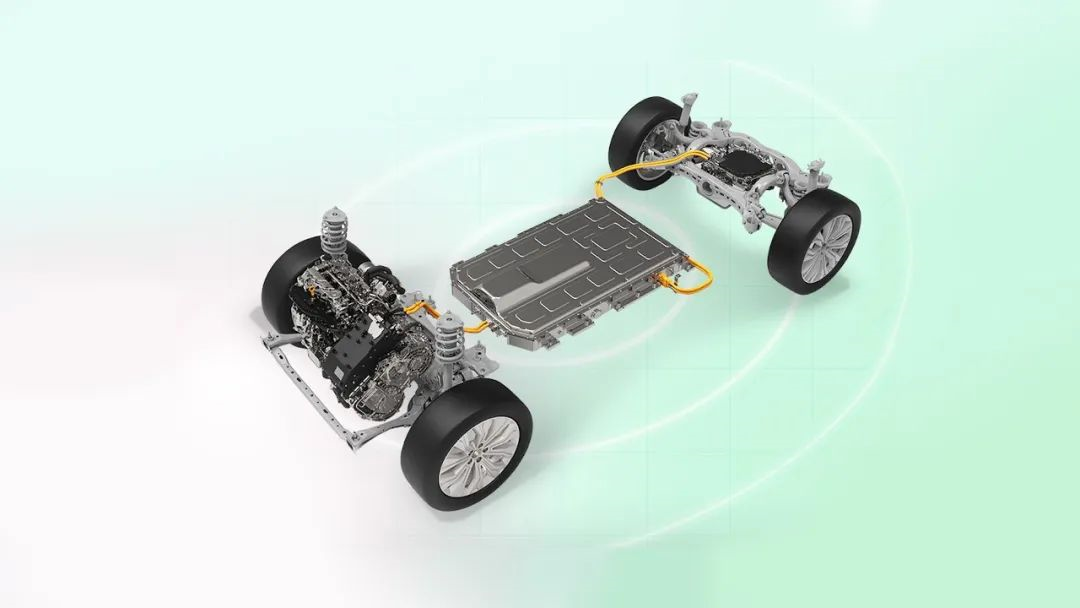Previously, many people often said a phrase “There are only two types of hybrids in the world, one is Toyota and the other is all others”. This is actually because the Toyota Hybrid System (THS) was introduced earlier and went through many generations of improvements, leaving a strong impression on many. Nowadays, with independent brands led by Great Wall’s entering the market, the pattern of hybrid technology seems to have undergone a change.
In the past, hybrid systems improved fuel economy to a certain extent due to the addition of motors, but their performance in terms of power, driving smoothness and quietness was not satisfactory. For example, some problems included poor acceleration at high speeds, sudden intervention of the engine, and excessive engine noise at high speeds.
So, is there an all-round hybrid system that can meet our desire for hybrid cars? Yes, there is, just like the Great Wall Lemon Hybrid DHT. As the earliest hybrid technology introduced by independent brands, the Lemon Hybrid DHT not only broke the monopoly and barriers of joint venture brands but also overcame the pain points of user experience brought by previous hybrid models.
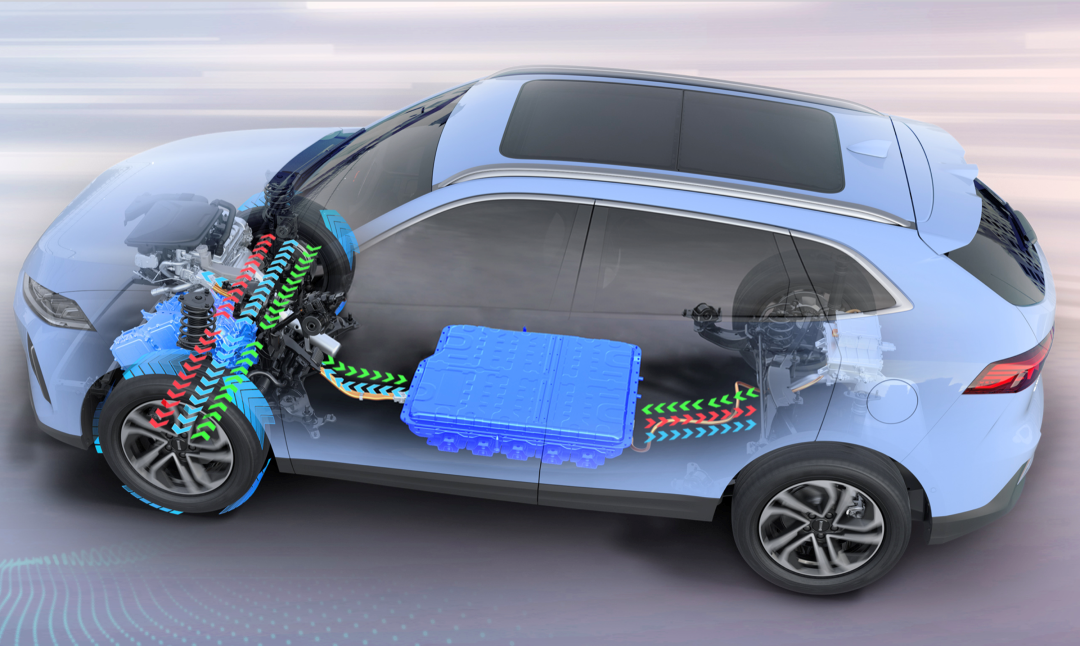
What is the Lemon Hybrid DHT?
Currently, the hybrid market has power distribution, single-speed hybrid, series-parallel, and oil-electric separation hybrid technology products. Among them, power distribution and single-speed hybrid have obviously inadequate power performance, and the power performance of series-parallel depends entirely on the performance of the motor.
The Lemon Hybrid DHT uses a different double-speed hybrid strategy, adopting a double-motor hybrid topology and considering more direct drive scenarios. Therefore, the Lemon Hybrid DHT has good performance in both power and economy.
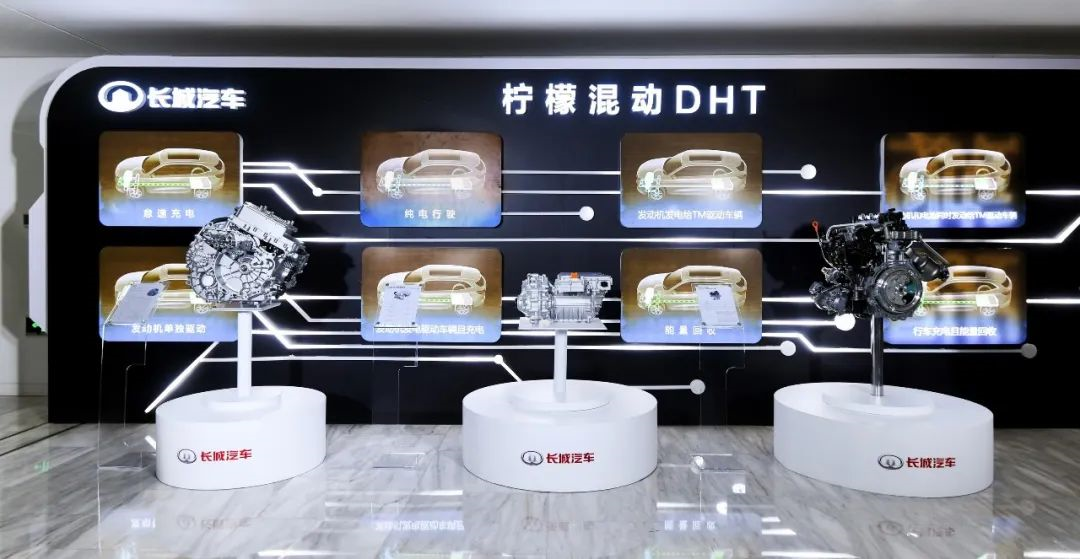
The Lemon Hybrid DHT is an efficient and high-performance hybrid technology scheme independently developed by Great Wall. The advantages of this hybrid system can be reflected in “1-2-3”, namely: 1 set of hybrid system, 2 types of powertrain, and 3 types of powertrain assembly.
- A set of hybrid system: “Lemon Hybrid DHT” is a multi-mode hybrid powertrain with a dual-motor hybrid topology;
- Two types of powertrain: Based on this hybrid system, two types of powertrain architecture are derived, namely HEV and PHEV;
- Three types of powertrain assembly: Under the two types of powertrain architectures, Lemon Hybrid DHT currently provides three types of powertrain assembly.
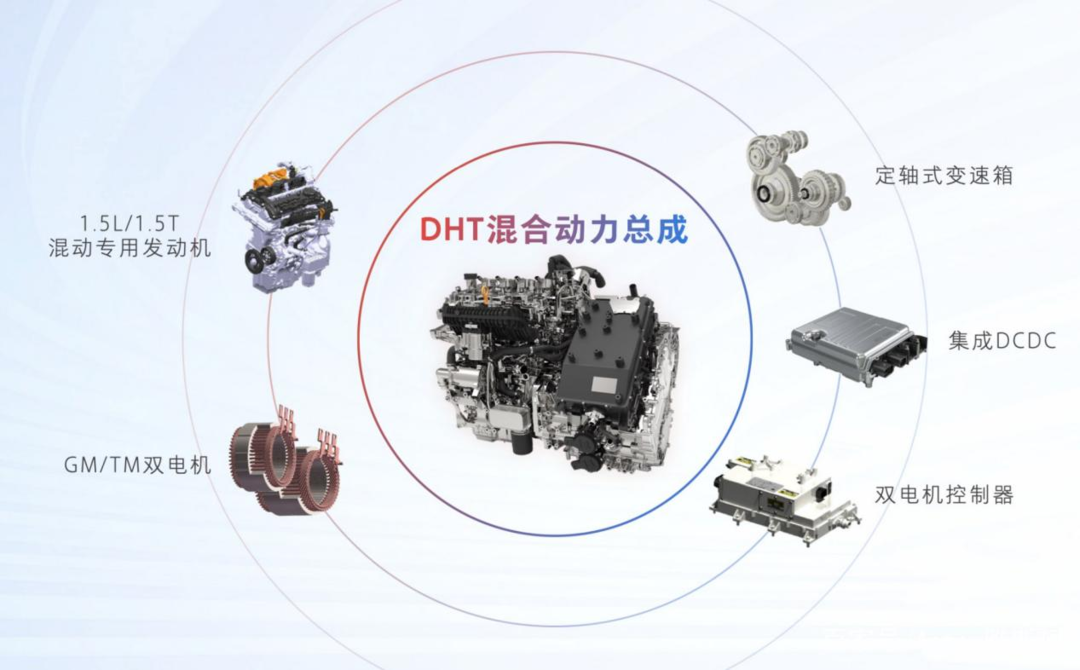 The Lemon Hybrid DHT offers three types of powertrains: “1.5L+DHT115”, “1.5T+DHT130”, and “1.5T+DHT130+P4”, all of which use a highly integrated seven-in-one configuration design, including a dedicated 1.5L/1.5T hybrid engine, GM/TM dual motors, dual motor controllers, integrated DCDC, and a fixed-axis gearbox. Compared to traditional fuel systems, the highly integrated design has smaller volume, lighter weight, higher transmission efficiency, and better NVH performance.
The Lemon Hybrid DHT offers three types of powertrains: “1.5L+DHT115”, “1.5T+DHT130”, and “1.5T+DHT130+P4”, all of which use a highly integrated seven-in-one configuration design, including a dedicated 1.5L/1.5T hybrid engine, GM/TM dual motors, dual motor controllers, integrated DCDC, and a fixed-axis gearbox. Compared to traditional fuel systems, the highly integrated design has smaller volume, lighter weight, higher transmission efficiency, and better NVH performance.
The system comprehensive power of 1.5L+DHT115 can reach 140-197 kW, 1.5T+DHT130 can reach 179-291 kW, and 1.5T+DHT130+P4 can reach 355 kW. It is significantly superior to Toyota THS’s 160 kW and Honda i-MMD’s 158 kW in the same level of products.
Thanks to the highly integrated hybrid powertrain with a fixed-axis gear, Lemon Hybrid DHT achieves a maximum transmission efficiency of over 97% and a comprehensive efficiency of over 50%. Therefore, in addition to stronger power performance, the Lemon Hybrid DHT also exhibits good fuel economy.
In addition, unlike most hybrid products on the market that only offer one powertrain, Lemon Hybrid DHT offers both HEV and PHEV powertrain options, providing more diversified choices to meet different consumer needs.
Compared to Toyota THS’s power distribution strategy, Lemon Hybrid DHT, like Honda i-MMD, uses engine direct drive strategy. However, unlike the single-speed hybrid i-MMD, the Lemon Hybrid DHT features a two-speed dedicated transmission, thus becoming a two-speed hybrid.
Compared to the single-speed hybrid, which has lower cost but higher engine speed when driving in parallel, the two-speed hybrid has better NVH performance and higher acceleration capability on highways.- The core of Toyota THS is the planetary gear set, through which the engine and motor are coupled without an electronic clutch. This reduces volume and weight. However, the rigid engagement of engine and gears make it difficult for the engine to maintain efficient operation in the optimal range, and neither the engine nor motor can operate at maximum power simultaneously. Therefore, the power performance of Toyota THS is mediocre.
- Honda’s i-MMD adopts the “fixed shaft series-parallel hybrid” and has good energy efficiency due to the low power and high thermal efficiency of the engine. However, the operating principle of Honda’s i-MMD is to drive the high efficiency mode with the electric motor when the engine cannot work efficiently, and there are relatively few engine-driven conditions, which results in weak power performance under medium and high speed conditions.
From the working mode of the Lemon Hybrid DHT, we can see that:
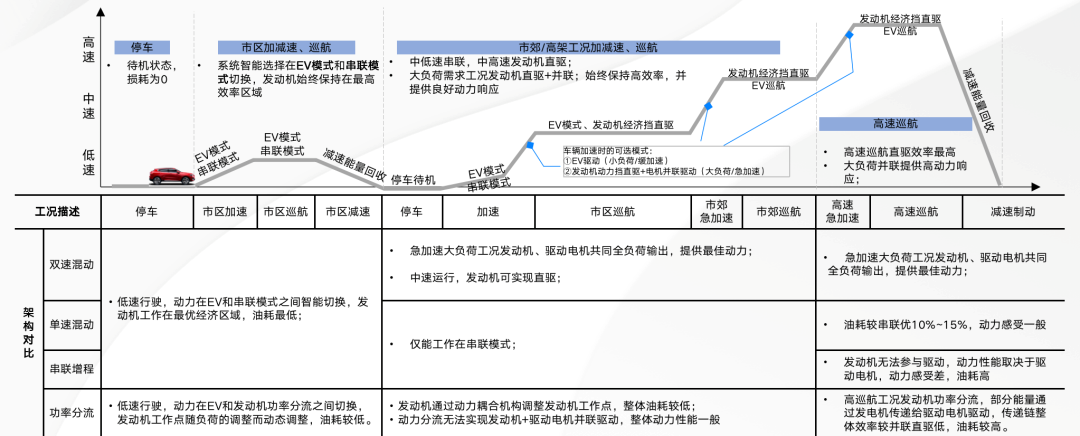
Lemon Hybrid DHT uses direct drive mode in power gear at low speed, and in economy gear at medium and high speeds, and uses power gear direct drive mode during rapid acceleration. It not only achieves two gear operations on the basis of series-parallel motors and engines, but also has more efficient direct drive gears, allowing the engine to always work in the high efficiency zone and thus play a greater role. Therefore, Lemon Hybrid DHT can minimize high-speed fuel consumption, and ensure sufficient power output under high-speed and rapid acceleration conditions, effectively solving the pain points of Toyota THS and Honda i-MMD.
It is obvious that when Great Wall Motors developed Lemon Hybrid DHT system, it considered both city low-speed travel and high-speed travel scenarios, bringing users the most intuitive experience of “fast and fuel-efficient”.

At the same time, Lemon Hybrid DHT can achieve power interruption and gear shifting, significantly improving the driving smoothness of hybrid models. The stator of the motor adopts a low harmonic winding structure, and the rotor adopts a three-stage inclined pole structure. The transmission uses a high gear overlap design, and has better NVH quietness performance.
Lemon Hybrid DHT can cover almost all Great Wall Motors’ product matrix, and meet the diversified needs of consumers through products with different positions. Models such as the Wey Mocha and Machedo have launched DHT-PHEV versions, and the Wey Latte DHT-PHEV will be launched soon. Models under Haval, such as the Chitu and Shenxiong, have also launched DHT-HEV versions.
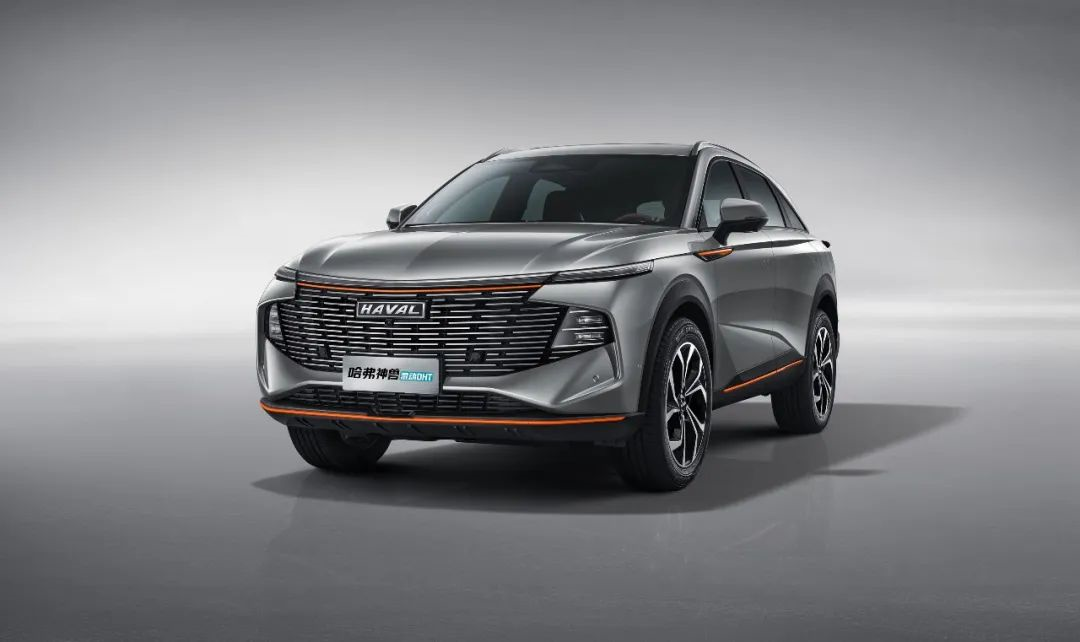
FinallyThe main reason for customers to choose hybrid cars is for fuel efficiency, but too many people have abandoned performance, smoothness, comfort, and so on in order to save fuel. Now, the appearance of the Great Wall Motor Lemon Hybrid DHT is to tell customers: you don’t have to make choices, Lemon Hybrid DHT gives you “all of it”.
Currently, it is highly possible that the future gasoline car market will be reshuffled by hybrid technology. In the “Energy-saving and New Energy Vehicle Technology Roadmap 2.0”, it is clearly proposed that “energy-saving vehicles and new energy vehicles each occupy 50% of the annual sales, and the automotive industry realizes electrification and transformation.”
Facing the upcoming “hybrid car era”, technology is the core element of market position. In addition, there must be more versatile product performance and a richer product line layout. All of these have been achieved by Great Wall Motor’s Lemon Hybrid DHT. Therefore, whether it is facing the future changes in the automotive market or the future needs of users, we need a “hybrid all-rounder” like Lemon Hybrid DHT.
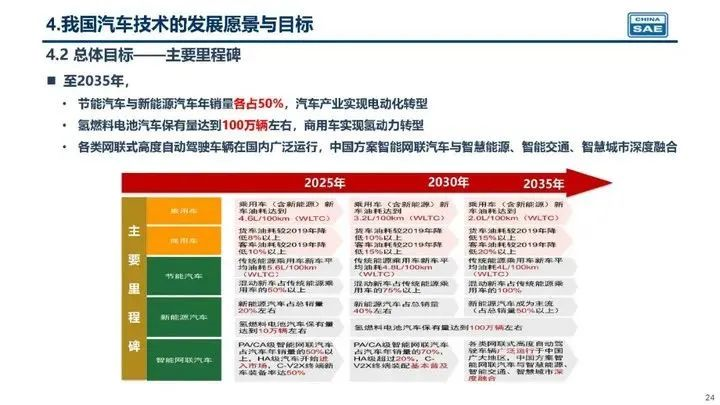
This article is a translation by ChatGPT of a Chinese report from 42HOW. If you have any questions about it, please email bd@42how.com.
